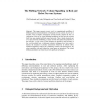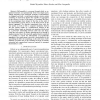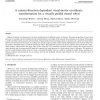246 search results - page 36 / 50 » Robot control with biological cells |
ECAL
2001
Springer
13 years 11 months ago
2001
Springer
This paper presents recent work in computational modelling of diffusing gaseous neuromodulators in biological nervous systems. It goes on to describe work in adaptive autonomous sy...
ICRA
2005
IEEE
14 years 10 days ago
2005
IEEE
- Polychaete annelid worms provide a biological paradigm of versatile locomotion and effective motion control, adaptable to a large variety of unstructured environmental conditions...
ICRA
2008
IEEE
14 years 1 months ago
2008
IEEE
Abstract— Self-assembly is a process through which an organized structure can spontaneously form from simple parts. Taking inspiration from biological examples of self-assembly, ...
SGAI
2005
Springer
14 years 6 days ago
2005
Springer
Objects of interest are represented in the brain simultaneously in different frames of reference. Knowing the positions of one’s head and eyes, for example, one can compute the...
ICRA
2000
IEEE
13 years 11 months ago
2000
IEEE
We describe a new theoretical framework for robot-aided training of arm movements. This framework is based on recent studies of motor adaptation in human subjects and on general c...



